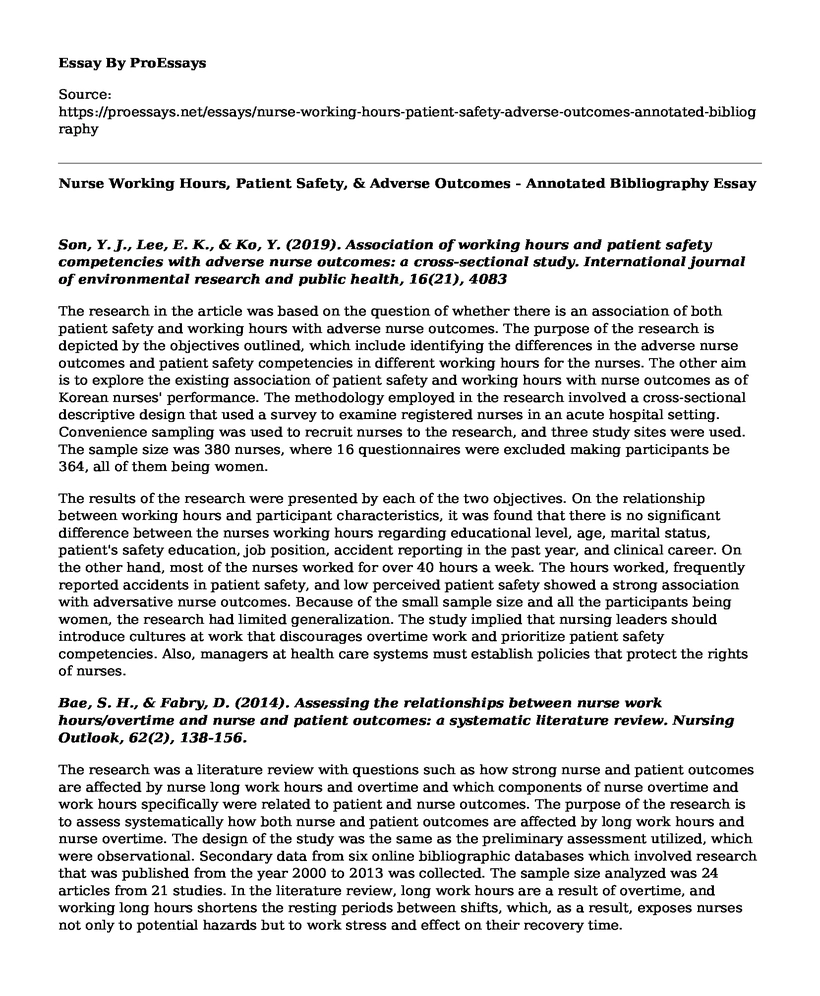Son, Y. J., Lee, E. K., & Ko, Y. (2019). Association of working hours and patient safety competencies with adverse nurse outcomes: a cross-sectional study. International journal of environmental research and public health, 16(21), 4083
The research in the article was based on the question of whether there is an association of both patient safety and working hours with adverse nurse outcomes. The purpose of the research is depicted by the objectives outlined, which include identifying the differences in the adverse nurse outcomes and patient safety competencies in different working hours for the nurses. The other aim is to explore the existing association of patient safety and working hours with nurse outcomes as of Korean nurses' performance. The methodology employed in the research involved a cross-sectional descriptive design that used a survey to examine registered nurses in an acute hospital setting. Convenience sampling was used to recruit nurses to the research, and three study sites were used. The sample size was 380 nurses, where 16 questionnaires were excluded making participants be 364, all of them being women.
The results of the research were presented by each of the two objectives. On the relationship between working hours and participant characteristics, it was found that there is no significant difference between the nurses working hours regarding educational level, age, marital status, patient's safety education, job position, accident reporting in the past year, and clinical career. On the other hand, most of the nurses worked for over 40 hours a week. The hours worked, frequently reported accidents in patient safety, and low perceived patient safety showed a strong association with adversative nurse outcomes. Because of the small sample size and all the participants being women, the research had limited generalization. The study implied that nursing leaders should introduce cultures at work that discourages overtime work and prioritize patient safety competencies. Also, managers at health care systems must establish policies that protect the rights of nurses.
Bae, S. H., & Fabry, D. (2014). Assessing the relationships between nurse work hours/overtime and nurse and patient outcomes: a systematic literature review. Nursing Outlook, 62(2), 138-156.
The research was a literature review with questions such as how strong nurse and patient outcomes are affected by nurse long work hours and overtime and which components of nurse overtime and work hours specifically were related to patient and nurse outcomes. The purpose of the research is to assess systematically how both nurse and patient outcomes are affected by long work hours and nurse overtime. The design of the study was the same as the preliminary assessment utilized, which were observational. Secondary data from six online bibliographic databases which involved research that was published from the year 2000 to 2013 was collected. The sample size analyzed was 24 articles from 21 studies. In the literature review, long work hours are a result of overtime, and working long hours shortens the resting periods between shifts, which, as a result, exposes nurses not only to potential hazards but to work stress and effect on their recovery time.
According to the researchers of this article, the reviews selected were limited to impacts of shift length of nurse outcomes as no reviews strongly evaluate systematically and rigorously the strength of the effect of overtime on nurse and patient outcomes. The findings were that there is strong evidence that supports the existence of a positive relationship between adverse outcomes and working long hours to the nurses. The nursing outcomes were found to be strong, while the patient outcomes were found to be inclusive. The relationship between adverse work hours and longer shift length was found to be strong. Also, the factors that were found to be significantly related to a higher occurrence of adverse nursing outcomes are mandatory overtime, insufficient breaks, and working voluntary overtime. The researchers recommend future research to focus mainly on longitudinal studies that address the relationship in this article.
References
Bae, S. H., & Fabry, D. (2014). Assessing the relationships between nurse work hours/overtime and nurse and patient outcomes: a systematic literature review. Nursing Outlook, 62(2), 138-156. https://doi.org/10.1016/j.outlook.2013.10.009
Son, Y. J., Lee, E. K., & Ko, Y. (2019). Association of working hours and patient safety competencies with adverse nurse outcomes: a cross-sectional study. International journal of environmental research and public health, 16(21), 4083. https://www.mdpi.com/1660-4601/16/21/4083
Cite this page
Nurse Working Hours, Patient Safety, & Adverse Outcomes - Annotated Bibliography. (2023, May 11). Retrieved from https://proessays.net/essays/nurse-working-hours-patient-safety-adverse-outcomes-annotated-bibliography
If you are the original author of this essay and no longer wish to have it published on the ProEssays website, please click below to request its removal:
- Research Paper on Family Nursing Practice
- Research Paper on Nursing Shortage
- Why the US Citizens Are Rapidly Becoming Obese: Annotated Bibliography
- Alzheimer Disease and the Problem Encountered by the Families of Patients Paper Example
- Essay Example on Marine Pollution: Impact on Biodiversity and Public Health
- Essential Resuscitation Equipment and Drugs for In-Hospital Cardiopulmonary Arrests - Essay Sample
- Report Sample on Mandatory Nurse Patient Staffing Ratios







